Supporting Individuals with Specific Healthcare Needs
Introduction
This assessment is consisted of two basic parts about the specific individual healthcare needs and their relevant practices in people and the second part presents a reflection of assessing all the healthcare practices needed for the care giving services to various individuals and evident their impacts. In assignment consists of a reflective report about the practices and a reflective practice log that will present the evidences gathered and factors of getting those evidences. The reflections, proofs and evidences were gathered from a practice session in a healthcare setting stating how to deal with the specific people’s specific needs which can be either simple or complex. The value-based healthcare practices and the stereotypes regarding them and specific needs of people are highlighted with reflection report log. Adding to this the experience of a manager of a healthcare setting and what he/she faced while working are stated with person-centred approach so that the challenges and behavioural traits of the individuals can be recorded with witnesses. The impacts of the government policies and local service providers’ provisions are also noted reviewing the individuals’ care plans and practices. The involvement of risk management and its need and importance is also narrated. Various strategies adapted in handling a care setting and the needs of those strategies are fully briefed with their importances also. For those seeking insights into similar reflective practices, healthcare dissertation help can provide valuable guidance.
Part 1
LO1: Assessing the factors that impact the healthcare services for the individuals with their specific needs.
P1: Describing the social and medical model of disability in relation to individuals with specific needs

There is a different concept in between the medical model and social model of the healthcare setting service providing where the medical model tries to find the remedies of the disability through the use of a medical cure practice or can be done by attempting to put that person in the frame of less disabled than the actual position and more trying to normalise that person more. Whereas, on the other hand, the social model is relevant to remedies of the disability that will create a change in the method of interaction between that specific individual and the society on the other side. According to Smith and Bundon (2018), the social model of disability presents the fact that the disability is mainly caused due to the way or o the methods which the society organises or uses. Contrasting this theory the medical model of disability states that the people who are disabled or impaired are made different by their impairments or differences from the other common people. Degener (2017) suggested that the medical model specifically looks towards the point that “what is wrong” with any person, not “what the person needs to correct that wrong” in them. There is a huge conceptual difference between both the social and medical models of disability in context with healthcare services.
The differentiation between the medical model approach of disability and the social model of disability approach can be further cleared with examples of both the concepts. Woods (2017) presented few examples related with the medical approach can be like a leader of a course who when refuses to help by producing a simple hand-out into a large font size for making it easy for the visually impaired students to see clearly. The social model of disability approach example can be like, if a person or any student is using a wheelchair but is unable to get into a building due to some of the stairs or steps in front of the building. Here in this example, both the models will think and analyse the reasons behind the inability of that student to enter. Retief and Letšosa (2018) stated that the medical model will suggest that the reason behind the inability is the wheelchair and not the steps whereas the social disability model will say that the steps are the reason behind the inability to enter in the building and the steps are the barrier making the student or the person disable and not the wheelchair.
Key differences between both the models
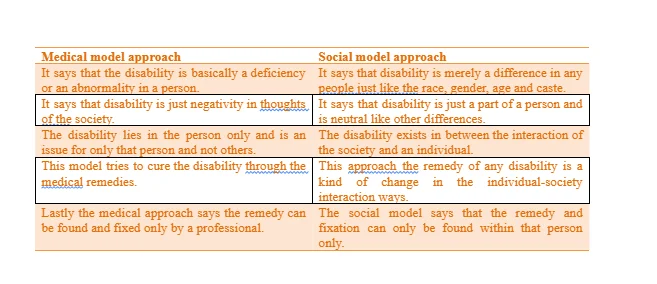
P2: Reviewing the factors that can lead to specific and complex needs
Healthcare needs have been mainly classified into two categories- one is specific and the other is complex. Both the categories are and their requirements are separate from each other so do the impacts of their facts (springer.com, 2020). The classification can be clearly stated with the factors putting an impact on both the type of needs. The factors of specific healthcare needs are listed as –
Resources and facilities are a big reason behind the specific needs of healthcare services of a person. It can be understood with the example like- if there is only one manometer to check the patients in a ward then it will definitely affects the quality of the overall work (Buckley et al. 2020). High quality output services always requires high quality input devices since a low quality input device always takes more time to do the job .
The managers in the public service providing settings and hospital don’t have the power to make decisions in their hands. As advised by Thomas-Henkel and Schulman (2017), the government policies and regulations restrict them from that which sometimes affects the medical needs and the medical conditions of the patients. The national government policies and regulations are insufficient to handle the immediate critical conditions with flexibility according to the local circumstances.
The price, income and financing methods are big factors impacting the healthcare needs and attitudes & behaviours of the healthcare providers (biomedcentral.com, 2019). These things are big factors that flexible the demands and needs of the people regarding the needs of the healthcare services.
All these factors impacts the flexibility and needs and demands of the specified healthcare services of the people in various places differentiated according to places and changes as per the demographic locations.
There is a huge difference in the factors affecting the complex healthcare needs and demands in people. The complex factors affects the needs due to some reasons which includes the complex tasks and their diversities involved while delivering them to the patients, the complexity also is dependable on the service providers, other staffs and patients’ attitude and behaviours (springer.com, 2020). There needs to be a good conversational relation between the service providers and the patients and other staffs which sometimes misses in the care settings. The complexity dependable factors are –
The complex factors are closely related with the quality healthcare factors whose characteristics are availability, accessibility, affordability, privacy, confidentiality, competency, appropriateness, acceptability, timeliness, attentiveness, responsiveness, caring, accountability, reliability, accuracy, equity, continuity, comprehensiveness, facilities & lastly amenities (biomedcentral.com, 2019). All these are the elements upon which the complexity or simplicity of the healthcare quality depends with patients.
The specific patient needs of the healthcare are simple and non-strategic in delivery which means that they dot need technique and plans to execute or provide but the complex needs are far different from those whose determinants are flexible according to the situations and demographics. Thomas-Henkel and Schulman (2017) opined that these can be as loyalty of the healthcare service providers and other staff members, patient satisfaction within the healthcare setting which is the primary important thing to consider and the productivity and goodwill of the healthcare centres which are also responsive from the view point of the patients and their families.
M1: Explanation of the historical perspectives of care provision for individuals with specific needs
Today’s physicians focus on serving the best to patients, giving them relief from their sufferings managing the limitations of today’s world of advanced knowledge, motives for enhancement of the overall public health, always tries to revert the epidemics and not to forget deals with the curing or minimising of the scourge of the diseases (biomedcentral.com, 2019). In the present scenario, all the major healthcare systems across the world are in a continuous process of trying their best to focus on improvising the policy efforts for the improvement in the quality of the specific and common healthcare needs to the individuals and people delivered to the public. All these were the perception of the recent times or the current thoughts but previously these were not there. Unlike from the 21st century healthcare system, in old times or historic centuries the medical practitioners were not capable to provide adequate treatment and also were uninformed about the deep core knowledge about the specific healthcare needs and their fulfilment ways for individuals.
D1 Discussing the changes and progress in healthcare service provision for individuals with specific needs
As compared with the past experiences, policies, regulations, laws, treatment facilities sand other aspects the recent times have developed in a hue manner. Now there are high-tech machines for treatment and their diagnosis and also the post treatment care services can also be given with these machines. In past times, there were no focus of the government on improvising the laws and acts of the healthcare facilities but as days passed government also formulated some very intriguing regulations and rules that impacted the better quality of healthcare treatment facilities. Funds from all over the aces were collected so that when here is a need to set any new arrangement and if there is unavailability of funds, at that time these were utilised to fulfil the requirements without interrupting the process (Buckley et al. 2020)..
The policies at historic times were able to promulgate all the people from the harm care, medications and increasing cost of the treatments since there were no such machines like today that will minimise the workload and will bring out the best possible treatment for specially the individual’s specific needs of treatment and care.
Part 2
LO2: Reviewing self-practices in providing support to individuals with specific healthcare needs using PLAD portfolio
P3: Reflection report on appropriate value-based care with an individual with specific needs
As a healthcare service provider, there are so many things that I have noticed several things relevant with the healthcare service providing system, their needs of specific care and complex care where there are various approaches through which the suitable care can be given to the patients. Here the Gibbs reflection cycle model in introduced by Graham Gibbs in the year 1988, this model is a structural method to express the learning from the experiences and to make a plan about the issues and solutions.
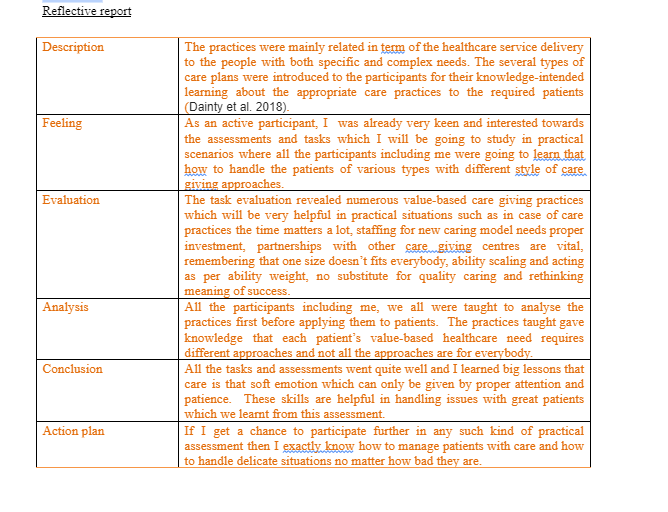
P4: Reviewing that how the planning in place supports the implementation of values-based practice in own work with the individual receiving care
Prejudices and stereotypes are very much common in the field of medical care giving and practices also. The stereotyping patients can be as per their race, weight, age, socio-economic status and gender or may be some other factors also (annallergy.org, 2020). All these factors which stereotype the care giving process puts huge negative impact on the health of people as recent researches revealed.
On the second level the needs can be met by applying a comprehensive solution which might be required to design specifically because every person’s needs are different so the solutions are also needed to be different since it says that “one shoe is not fit for everybody” (sciencedirect.com, 2018). The solutions must fulfil the desired outcome from that solution else it is of no use to apply that.
After application, now comes measuring the outcomes which was archived and compare whether they are up to the desired outcome or not. The best results of the value-based practices can be attained by making partnerships in the care giving process (nih.gov, 2017).
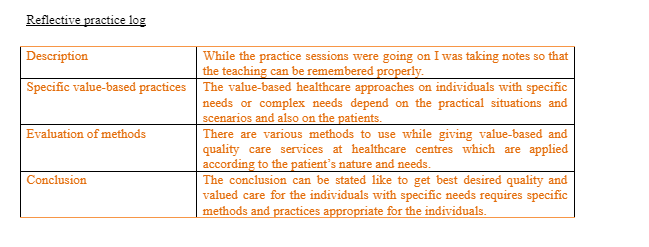
M2: Reflection on how aspects of own care practices meet the needs of the individual with specific needs with the impact of stereotypes and prejudices
The needs of specific individual care needs can be met by the care practices learnt despite managing the prejudices and the stereotypes can only be possible with the support of certain competencies whose presence are a must as being a care professional. These such competencies includes –
The initial requirement is that all the care professionals must have to acquire the knowledge about how to deliver the patient-centred care services being an active member of the interdisciplinary medical team who mainly emphasises on the evidence-based practices (sciencedirect.com, 2018).
Proper utilisation of the informatics of the patients to communicate, manage the process, resolve the issues raised and supporting the decision making process is necessary ignoring the stereotype sand prejudices.
Application of the quality-based improvement practices helps in identifying the errors and hazards present in the care practices and keep the understanding and implementation of safety-based care designs to give quality specific needs to the individuals (sciencedirect.com, 2018).
In addition the implementation of evidence-based care practices integrates the best possible clinical and research patient values and expertise so that the optimum specific care including the research and learning activities can be included to extend the healthcare feasibility in case of both public and individuals (Dainty et al. 2018).
D2 Critically analysing own practice in terms of its effectiveness in addressing the impact of values and stereotypes of individuals with specific needs
The practices adopted in the effective addressing of the values that impact the prejudices and the stereotypes connected with the individuals with specific healthcare needs are much influential. It is the result of these practices that at present we have such a good quality healthcare systems all around the world which made it so easy for the patients to get treated with pure essence of good behaviour& polite nature of the service providers, cost effective treatment plans which have been made possible only with the attention that government let focus on the healthcare systems of the local provision (annallergy.org, 2020). So it can be said that there were positive results seen as compared with old times but still there are rooms for further advancements and development which are waiting to get focussed soon. The expansion of partnerships is useful in many other ways also where latest high-tech devices can be acquired for best care treatments (nih.gov, 2017). The value-based practices re those practices which are intended with all the measures to tackle every type of situation while giving care to the patients in care homes.
LO3: Assessing the local service provision for the support of individuals with specific needs
P5: Reviews on the local provision for individuals with specific needs
The specific needs of the individuals’ regarding healthcare cam are executed by analysing a lot of concepts of healthcare practices regardless of the users of those services. Healthcare is a vital element and an important aspect which mainly focuses on the good health and well-being of people the society. There are various types of laws, rules and regulations of the local government regarding the healthcare service providing and healthcare centres to give better functioning to the people without faults and mistakes (World Health Organization, 2020). All these laws, acts and regulations put impact on the social policies, culture and legislations on the service quality and the availability or unavailability of the services so that the specific needs of an individual can be met.
There are so many health conditions like diabetes, heart issues, over weight problems, skin problems, hair issues and many more which are spreading day by day in people. And all these are due to negligence in healthcare and lack of motivations about the care taking of own self in every individual (Paulauskaite et al. 2017). The local provisions of the laws and acts sometimes put restrictions in daily needs of the decisions which need to be taken as soon as possible. Due to this the condition of people’s heath is slowly detoriating in most of the places. Adding to this it can also be said that the specific individual needs differentiates in people as per their age of that person in adapting the treatment and accepting the medications according to the level of disease and condition of the body (Josefy et al. 2017).
The impacts of the local laws, acts and provisions on the specific individual healthcare needs differs depending upon the social policies, legislations, society and culture and their impacts of the availability of healthcare services on the individual specific needs (Reddick et al. 2017).
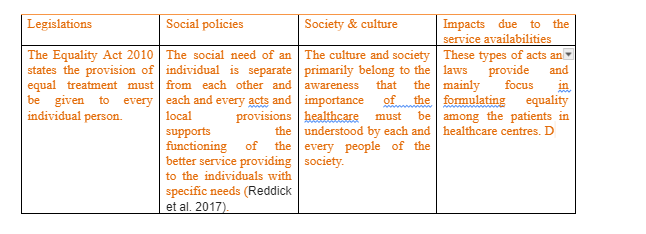
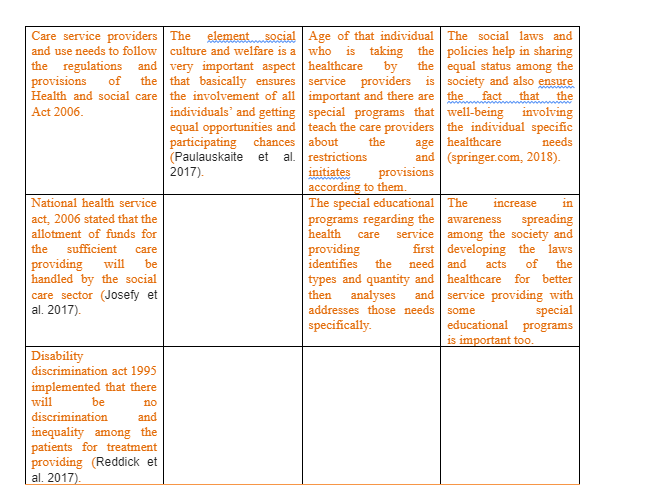
M3: Reviews on the changes in government policy that have influenced development of local provision and support
There are certain changes which the government took and have influenced the improvement of the local provision and supported towards the healthcare needs of people including the individual specific needs. The local social and healthcare council organisations worked together joining hands with the government to meet the peoples’ needs and government contributed 2.7 billion to the local healthcare council bodies to team up with NHS for social care and service providing. Adding to this, government funded the local healthcare councils with an extra financial support of 100 million during the year 2013-2014 and 20 million during the year 2014-2015 for arranging high quality and technological machines for treatment of the patients and diagnosis in the local care setting provisions (springer.com, 2018).
Government separately prepared personal health budgets to people so that they can set their care plans for themselves and families according to their choices and spend upon them. Later on these personal budgets were combined and merged with social care budget so that whenever issues or barriers will raise, the integrated care support must remove them depending upon the evidence-based care practices in the local healthcare setting provisions. Government invited different experts and pioneers to demonstrate and develop unique and innovated approaches for efficient delivery of integrated care services for local people (World Health Organization, 2020). Another two main points on which government emphasised are the developing coordination among the care teams themselves and with the patients getting treated and secondly providing overall knowledge to people about what treatment process they will get and informing them about their assessment and information process so that they can also be aware of what care they are getting.
D3 Evaluating the importance of person-centred approaches to supporting inclusive services for individuals with specific needs
The person-centred approach is the core essence of the individual treatment with the specific care needs without this it is impossible to formulate such kind of care facilities to people. As the environment is changing and the social and health conditions of people are also changing, the need of specified individual needs are also increasing and their demands have also been changing within time. Drake and Bielefield (2017) stated that the need of every single person is different from the other person and it is dependent on the healthcare habits, lifestyle habits and diet habits. The person-centred approaches I support of the inclusive care services for individual’s specific care requirements focus on discussing about the needed changes in the care centres or care providing methods in time and fix the manner or perception of specific individual need in respect of the local provisions.
Most importantly there are certain parameters which the risk management must follow like self-reliance, resilience, freedom of choice, spirit of involvement and accurate informative treatment; all these are from the perspective of the individuals who demands specific care provisions, whose attainment can only be possible by involving the person-centred approaches in the risk managing system (Fegert et al. 2020).
LO4: Reflection upon the challenges of promoting person-centred service provision for individuals with specific needs
P6: Describing the challenges that can affect the level of care received by individuals
Numerous studies have analysed the quality of the healthcare services and their impacts on individual persons for their specific needs abut there are a lot of challenges also exists in the care giving process. Challenges such as proper medication, appropriate techniques for treating different people with different toes and stages of diseases and harmlessness in those care services which are considered as important as the impacts of those services are (Schultz et al. 2018). Some of the most common and considered challenges in the healthcare service providing field are –
The health professional are qualified but the education needs to be improved simultaneously as the diseases are increasing and the technologies are upgrading too. Without improvement in the continuous learning hand knowledge gaining no practitioner can be highly qualified and upgraded with time and provide better services to people with specified medical needs (Fegert et al. 2020).
The most important challenge is maintaining the cyber security because these days as the technology is developing so d their misuse are also increasing in umbers. So to maintain the confidentiality of the patients with high-end technological security system is needed and that is very much high cost so this kinds of creates a barrier in better security system in healthcare systems (Schultz et al. 2018).
Unlike other professions, the care giving profession is more sensitive, emotional, responsive, disciple-filled and patience-filled so the interest of people in this sector or in this field as profession is very much less as compared with the other professions (biomedcentral.com, 2018).
The rising cost of the healthcare services including the medications, testing devices, pathology instruments, diagnosing machines and many more are rising in their prices creating problems to make them available in all the healthcare settings (Fegert et al. 2020). The high cost makes it very challenging to make them afford to set ups in all the healthcare centres whether small or big.
The changes coming in the regulations, acts and laws in the functioning of the healthcare centres are changing day by day with increasing the complexity in maintain them and work by following them and not to mention by providing the best possible care giving also is added (biomedcentral.com, 2018).
P7: Explaining the strategies used in managing any challenging behaviours in own workplace setting
The challenging scenarios in the challenging behaviour are that factor that is the reason behind the significant danger or may be the distress to the healthcare concerns. The challenging behaviours in the workplace settings may occur due to a lot of serious reasons which have some specific definite measures to solve those challenges. As suggested by McCloughen and Foster (2018), these behaviours if becomes very critical and aggressive then the person facing this can be highly affected by that as he/she can feel fearful to further go to the workplace and work or there could be permanent resistance to work due to losing the confidence in them. So it is very delicate and important that these challenges can be faced properly with exact strategies to minimise its effect on the respective person. There are so many strategic remedies to handle the workplace challenging behaviour, from them few are listed here –
Building empathy and rapport
It is necessary to show the required amount of empathy along with understanding the appropriate situation of their behaviour and state of mind. It happens that critical and rough challenging behaviour comes from any specific sumptuous reason and at that time that behaviour needs to be understood and calmed down to bring it back to normal. Frenkel (2019) opined that the rough and angry or frustrated behaviour should never be reacted with anger since it could inflame the situation more.
Changing the environment
Another way to avoid the challenging behaviour can be avoiding the current situation for some time by moving away from that place but it will only work for a short term challenging behaviour but if the behaviour is permanent then this would be of no use (biomedcentral.com, 2017). Moving away for some time from that place will also give time to think that how to manage the scenario or how can it be solved.
Explore to the root cause of the challenging behaviour
Sometimes knowing the main reason behind the challenging behaviour is good for tolerating or managing those situations. The two points “why” and “what” are important to be known to resolve any situation. As stated by Jha and Varkkey (2018), listening the root cause, summarising them according to the requirement and reflecting back with appropriate behaviour can be helpful a lot.
Focusing on the desired future outcome
Sometimes it’s better to ignore the behavioural issue and focus mainly on the goals and the desired outcomes for which the participation is initiated so that the outcome can be attained with less problems and issues and with short time or the expected time. McCloughen and Foster (2018) detailed that handling the challenges in workplace takes time and few people don’t take it good that goal achievement will be delayed due to small and silly challenging behavioural issues. So it’s better to ignore and continue the work peacefully and get what you want as soon as possible.

M4: Reflection on own role in facilitating appropriate risk management in person-centred approaches for individuals with specific needs
The formulation of risk management policies can only work best if it is prepared according to the person-centred approaches variants. This is important because risk in healthcare varies from person to person so it is vital that there must be followed the person-centred approach to attain the best possible results of the risk management policies (biomedcentral.com, 2017). The person-centred approaches are highly charged and politically loaded to build those risk managing strategies which alliance to support the person cutting across them and face all the challenges with creative ways. These identify what tings are important for a person from their own perspectives and finds solutions according to that. Person-centred approaches support individuals in choosing that who will take the charge of informing the risks involved so that the equality of the treatment can be improved (Schultz et al. 2018). Adding to this it swamps the independent critical imagination & managerial attention of experiments and learning rather than utilising the rule-based policies. The parameters of self-reliance, resilience, freedom of choice, spirit of involvement and accurate informative treatment must be taken care of in accordance with the person-centred approach while planning for the risk management for individuals with specific needs.
Conclusion
The conclusion of this assessment says that there is a huge conceptual difference between both the social and medical models of disability in context with healthcare services. This assessment is consisted of two basic parts about the specific individual healthcare needs and their relevant practices in people and the second part presents a reflection of assessing all the healthcare practices needed for the care giving services to various individuals and evident their impacts. The health professional are qualified but the education needs to be improved simultaneously as the diseases are increasing and the technologies are upgrading too. In this arena the educational facilities of the care service provides are limited and restricted up to a certain level. The social need of an individual is separate from each other and each and every acts and local provisions supports the functioning of the better service providing to the individuals with specific needs. Healthcare is a vital element and an important aspect which mainly focuses on the good health and well-being of people the society. There are various types of laws, rules and regulations of the local government regarding the healthcare service providing and healthcare centres to give better functioning to the people without faults and mistakes. Lastly it can be concluded that the healthcare is very vital and essential part of human life and taking care of that is a daily habit.
Dig deeper into Support Networks on the Care of Vulnerable Adults with Dementia with our selection of articles.
References
annallergy.org, 2020. Achieving the Quadruple Aim to deliver value-based allergy care in an ever-evolving health care system, available at: https://www.annallergy.org/article/S1081-1206(20)30235-0/fulltext [Accessed on: 26th February, 2021]
biomedcentral.com, 2017. Effective behaviour change techniques for physical activity and healthy eating in overweight and obese adults; systematic review and meta-regression analyses, available at: https://ijbnpa.biomedcentral.com/articles/10.1186/s12966-017-0494-y [Accessed on: 4th April, 2021]
biomedcentral.com, 2018. Challenges of conducting research in long-term care facilities: a systematic review, available at: https://bmcgeriatr.biomedcentral.com/articles/10.1186/s12877-018-0934-9 [Accessed on: 19th March, 2021]
biomedcentral.com, 2019. Implementation fidelity of a strategy to integrate service delivery: learnings from a transitional care program for individuals with complex needs in Singapore, available at: https://bmchealthservres.biomedcentral.com/articles/10.1186/s12913-019-3980-x [Accessed on: 16th January, 2021]
Buckley, S., Tickle, A. and McDonald, S., 2020. Implementing psychological formulation into complex needs homeless hostels to develop a psychologically informed environment. Journal of Social Distress and Homelessness, pp.1-10.
Dainty, K.N., Golden, B.R., Hannam, R., Webster, F., Browne, G., Mittmann, N., Stern, A. and Zwarenstein, M., 2018. A realist evaluation of value-based care delivery in home care: the influence of actors, autonomy and accountability. Social Science & Medicine, 206, pp.100-109.
Degener, T., 2017. A new human rights model of disability. In The United Nations convention on the rights of persons with disabilities (pp. 41-59). Springer, Cham.
Drake, A.A. and Bielefield, A., 2017. Equitable access: Information seeking behavior, information needs, and necessary library accommodations for transgender patrons. Library & Information Science Research, 39(3), pp.160-168.
Fegert, J.M., Vitiello, B., Plener, P.L. and Clemens, V., 2020. Challenges and burden of the Coronavirus 2019 (COVID-19) pandemic for child and adolescent mental health: a narrative review to highlight clinical and research needs in the acute phase and the long return to normality. Child and adolescent psychiatry and mental health, 14, pp.1-11.
Frenkel, S., 2019. 9. Patterns of Workplace Relations in the Global Corporation: Toward Convergence? (pp. 240-274). Cornell University Press.
Jha, J.K. and Varkkey, B., 2018. Are you a cistern or a channel? Exploring factors triggering knowledge-hiding behavior at the workplace: evidence from the Indian R&D professionals. Journal of Knowledge Management.
Josefy, M., Dean, T.J., Albert, L.S. and Fitza, M.A., 2017. The role of community in crowdfunding success: Evidence on cultural attributes in funding campaigns to “save the local theater”. Entrepreneurship Theory and Practice, 41(2), pp.161-182.
McCloughen, A. and Foster, K., 2018. Nursing and pharmacy students’ use of emotionally intelligent behaviours to manage challenging interpersonal situations with staff during clinical placement: A qualitative study. Journal of Clinical Nursing, 27(13-14), pp.2699-2709.
nih.gov, 2017. Redefining Health: Implication for Value-Based Healthcare Reform, available at: https://www.ncbi.nlm.nih.gov/pmc/articles/PMC5376155/ [Accessed on: 16th March, 2021]
nih.gov, 2020. Implementing models of care for musculoskeletal conditions in health systems to support value-based care, available at: https://www.ncbi.nlm.nih.gov/pmc/articles/PMC7382572/ [Accessed on: 7th January, 2021]
Paulauskaite, D., Powell, R., Coca‐Stefaniak, J.A. and Morrison, A.M., 2017. Living like a local: Authentic tourism experiences and the sharing economy. International Journal of Tourism Research, 19(6), pp.619-628.
Reddick, C.G., Chatfield, A.T. and Ojo, A., 2017. A social media text analytics framework for double-loop learning for citizen-centric public services: A case study of a local government Facebook use. Government Information Quarterly, 34(1), pp.110-125.
Retief, M. and Letšosa, R., 2018. Models of disability: A brief overview. HTS Teologiese Studies/Theological Studies, 74(1).
Schultz, W.M., Kelli, H.M., Lisko, J.C., Varghese, T., Shen, J., Sandesara, P., Quyyumi, A.A., Taylor, H.A., Gulati, M., Harold, J.G. and Mieres, J.H., 2018. Socioeconomic status and cardiovascular outcomes: challenges and interventions. Circulation, 137(20), pp.2166-2178.
sciencedirect.com, 2018. Population Health and Tailored Medical Care in the Home: the Roles of Home-Based Primary Care and Home-Based Palliative Care, available at: https://www.sciencedirect.com/science/article/pii/S0885392417305420 [Accessed on: 6th April, 2021]
Smith, B. and Bundon, A., 2018. Disability models: Explaining and understanding disability sport in different ways. In The Palgrave handbook of paralympic studies (pp. 15-34). Palgrave Macmillan, London.
springer.com, 2018. What do we know about community-based health worker programs? A systematic review of existing reviews on community health workers, available at: https://link.springer.com/article/10.1186/s12960-018-0304-x [Accessed on: 5th January, 2021]
springer.com, 2020. The patient at the centre: evidence from 17 European integrated care programmes for persons with complex needs, available at: https://link.springer.com/article/10.1186/s12913-020-05917-9 [Accessed on: 16th February, 2021]
Thomas-Henkel, C. and Schulman, M., 2017. Screening for social determinants of health in populations with complex needs: implementation considerations. Center for Health Care Strategies, 10.
Woods, R., 2017. Exploring how the social model of disability can be re-invigorated for autism: in response to Jonathan Levitt. Disability & Society, 32(7), pp.1090-1095.
World Health Organization, 2020. Considerations for quarantine of individuals in the context of containment for coronavirus disease ( COVID-19): interim guidance, 19 March 2020 (No. WHO/2019-nCoV/IHR_Quarantine/2020.2). World Health Organization.
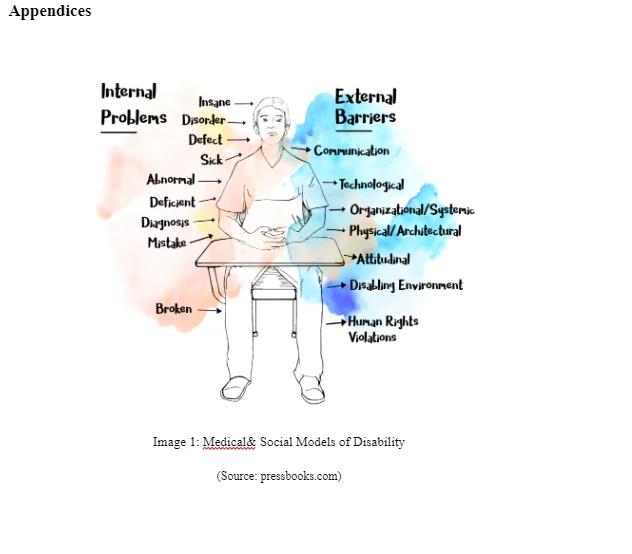
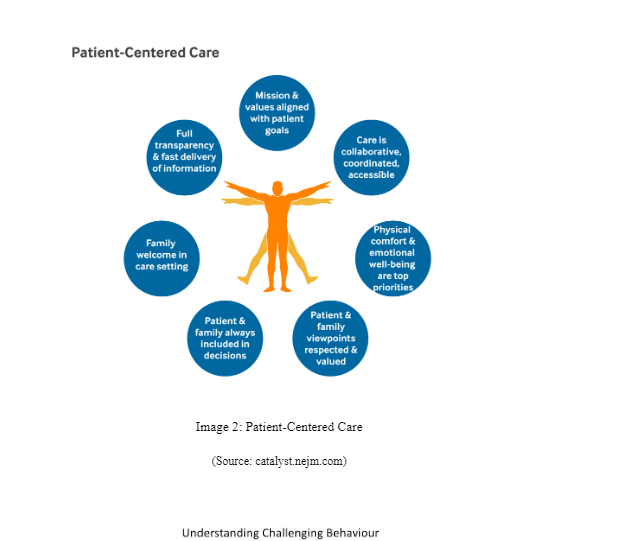
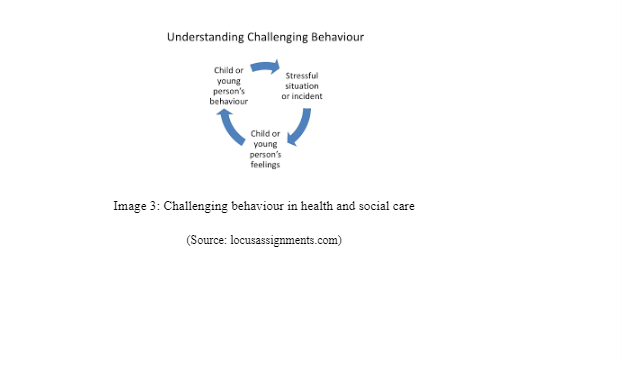
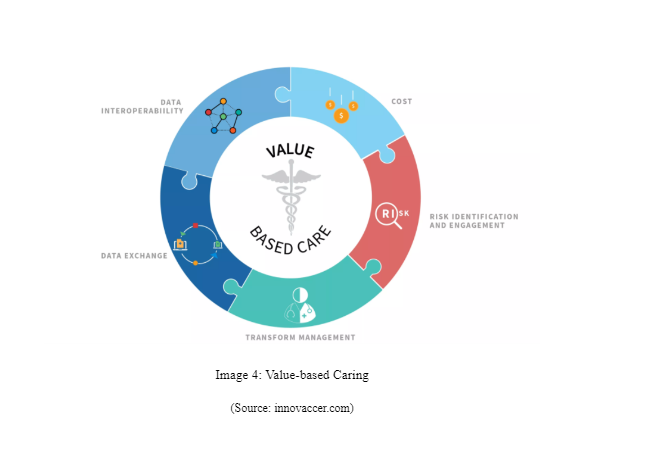
- 24/7 Customer Support
- 100% Customer Satisfaction
- No Privacy Violation
- Quick Services
- Subject Experts



